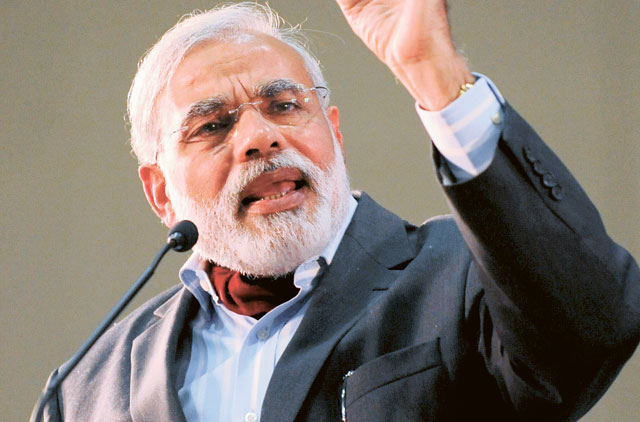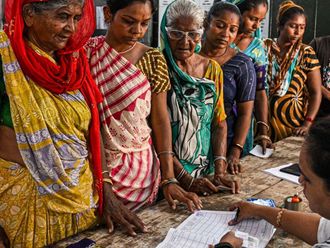After relations with India had cooled in recent years, thanks to several incidents that generated resentment against the US, the US administration is now losing no time to patch up with India and, particularly, the Prime Minister-elect Narendra Modi, the victor of the just-ended marathon election in the world’s biggest democracy.
The sheer size of Modi’s victory has been mind-boggling; the Indian electorate has given Modi a clear mandate to implement his party Bharatiya Janata Party’s manifesto which resonated well with the voters whose daily life is plagued by rampant corruption, spiralling inflation, lacklustre governance and economic slowdown under the weak leadership of former Congress prime minister Manmohan Singh.
Sensing a Modi victory — and not to be left behind by overzealous Europeans, Japanese and others, who were courting the Gujarat chief minister — the US administration ended in February this year its decade-long boycott of Modi whose US visa was revoked in 2005 because of his alleged inaction over the anti-Muslim riots that occurred in Gujarat in 2002, resulting in the killings of some 1,000 people, mostly Muslims.
The US was, in fact, the last to officially end boycott of Modi. Delhi-based European and other ambassadors — even communist China seemed impressed by what the Chinese media called the “Gujarat economic model” — had already lined up to meet Modi. The US ambassador in India, Nancy Powell, finally visited Modi in February and held closed-door talks with the latter for over an hour.
With Washington now congratulating and extending an invitation to Modi to visit the US, the visa cancellation appears, in hindsight, like a reckless miscalculation.
Many US officials privately acknowledge that revoking Modi’s visa was a “bad decision” which was based on a rarely used 1998 law which bars entry into the US of any foreign official considered responsible for severe violations of religious freedom. US Congress passed in 1998 the International Religious Freedom Act which set up new mechanisms to combat religious persecution, including a Commission on International Religious Freedom. The well-meaning CIRF, trying to show its concern for all faiths, naively recommended to the State Department to cancel Modi’s visa for his alleged inaction in the anti-Muslim riots in Gujarat.
But even before India’s election results were announced and Modi declared victor, the Obama administration was privately trying to overturn the decision whose genesis goes back to the Bush administration. Indeed, many experts, including Ashley Tellis, a specialist on South Asia at the Carnegie Endowment for International Peace, described the visa denial as merely symbolic. Obama’s administration was keen to establish a strategic partnership with India, and restore a meaningful and cordial relationship with whosoever became India’s new prime minister.
Untapped potential
Notwithstanding the visa denial, Modi had always maintained connectivity with the financially powerful Indian diaspora in the US, as well as the US trade and industry by addressing them through satellite. Two-way India-US trade is worth some $100 billion (Dh367 billion) and US think tanks say that there is still huge untapped potential.
Modi’s victory has been applauded by US businesses and industry, including the US-India Business Council whose chairman Ajay Banga said its member companies were ready “to roll up their sleeves and get to work with the new government”. India is an important US investment destination.
Obama sees India as a key player in the US strategy of rebalancing US diplomatic and military resources towards the Asia Pacific region, hailed as the world’s most dynamic economic region. All the major think tanks, including the prestigious New York based Council on Foreign Relations, have underscored India’s “great significance” as a strategic partner of the US and an important player in the Asia- Pacific theatre.
Obama has even supported the idea of India being given a permanent seat in the United Nations Security Council (UNSC).
However, US-India relations, which were losing momentum during Prime Minister Manmohan Singh’s last two years, suffered another setback last year following the arrest and strip-search of Indian deputy consul general in New York, Devyani Khobragade, by the New York police on charges of paying her maid servant “slave wages” and violating US labour laws. Khobragade’s treatment caused outrage in India; Indian politicians exploited the emotionally-charged atmosphere to score brownie points on the domestic front, ignoring the harm they did to national interests.
However, by inviting Modi to visit the US, Washington has finally cut what came to be known as the “Gordian visa knot”. Though an official visit will take some time to materialise, Modi will accept the invitation to visit the US which still remains, for most Indian politicians, the most-cherished political destination to visit.
Washington’s first reaction to Modi suggests it is working on the “let-bygones-be-bygones” premise. India is too important for Washington’s Asia pivot. US strategists also see India as a strong counterweight to China whose belligerent posturing on the South China Sea dispute and other issues is unnerving many countries.
Modi and the new BJP government now have an opportunity to build a strong partnership with Washington while not losing sight of their focus on economic growth and business, eradication of corruption, job creation and an all-inclusive development.
Manik Mehta is a commentator on Asian affairs.










